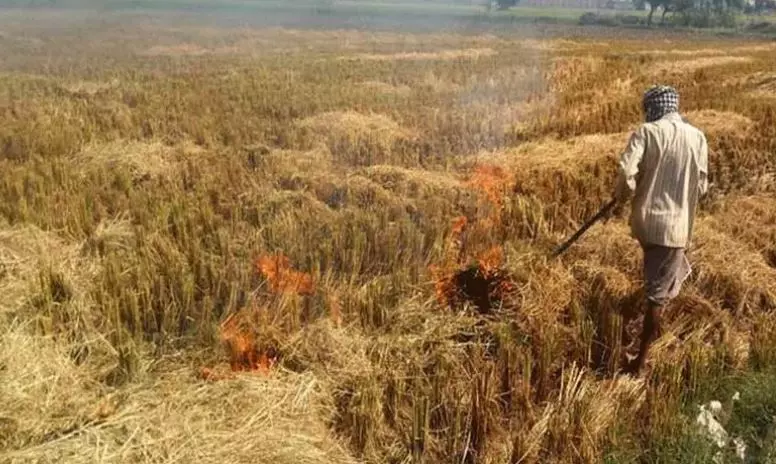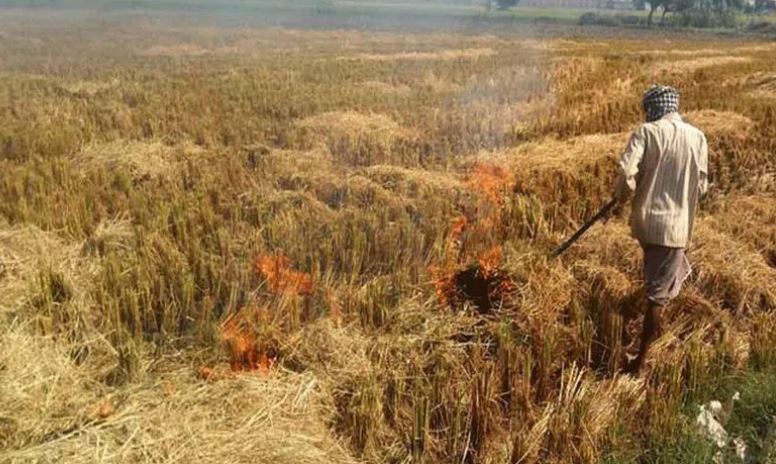
Hyderabad:Lakhs of tonnes of toxic carbon dioxide, carbon monoxide, nitrous oxide, sulphur dioxide, potassium and particulate matter in the form of soot are being added to the air over Telangana with an increasing number of farmers in the state resorting to stubble burning at the end of the Kharif crop season.
While the practice is already contributing to the severity of air pollution in the state spoiling air quality in rural areas, it is estimated that just the cost of supplementing the lost soil nutrients on account of stubble burning could be a staggering `3,472 crore if farmers were to replace the nutrients with chemical fertilisers.
Stubble burning has become a matter of such serious concern for the government that agriculture minister Tummala Nageswara Rao has been urging farmers, since the end of the previous rabi season in May, to desist from the practice, and instead use the material, a nutrient resource, for the next crop season by incorporating it back into the soil.
If farmers were to replace the nutrients that can be provided by the burnt stubble if it is used properly, they would have to spend around `3,472 crore to buy chemical supplements, said Dr T. Prabhakar Reddy, programme coordinator of Krishi Vigyan Kendra at Palem in Nagarkurnool district.
During the just concluded kharif crop season, Telangana farmers grew paddy in around 65 lakh acres and cotton in 43 lakh acres totalling 1.08 crore acres under these two crops.
Dr Prabhakar Reddy said that post the harvest, each acre is left with around 20 quintals of ‘waste’ in the form of straw and stubble. For paddy, this varies between 20 and 25 quintals and for cotton this figure is put at around 20 quintals. Between the two crops, farmers in the state could be facing the daunting task of getting rid of some 2,160 lakh tonnes of stubble from their fields, according to the institution.
However, with most of these options requiring substantial effort, and costs, it is early days yet in terms of which way the farmers will go on this issue.
But there does appear to be a sort of silver lining to the problem with experts saying that not every farmer in the state sets fire to the crop residue. According to Prof. Ch. Damodar Raju, principal scientist (rice), and head of Institute of Rice Research at PJTAU, around 50 per cent of farmers resort to stubble burning in the state, but added that it is still a matter of serious concern.
Much of the straw comes from paddy as cultivation of this crop has risen from around 15 to 20 lakh acres earlier to the present 65 lakh acres during kharif. And good rains, ground water availability, and the resultant irrigation, have also led to a rise in paddy farming during rabi season. The consequence is that there is more straw left in the fields and one of the worst outcomes of stubble burning is destruction of soil quality, Prof. Raju said.
With stubble burning taking root in the state and already on in different districts, “the situation is fast turning alarming,” a senior state government official said. “You can already see layers of smoke enveloping several rural areas and roads till 9 am,” the official added.
Asked about the air pollution caused by stubble burning, the member secretary of Telangana Pollution Control Board, Ravi Gugulothu, said that the board has urged the agriculture department to control fires. There is nothing the PCB can do to stop the farmers. It is for the agriculture department to take action to stop the fires, he said, making it clear that the TGPCB, mandated to curb air pollution in the state among its other duties, takes no further interest in the matter.
Dr Ch. Ravali Reddy, an assistant professor at SR University in Warangal, who researched the impact on fire on the soil biome while at PJTAU, pointed out that this sort of burning has been going on in many districts, particularly in Karimnagar, Adilabad, and Warangal for many years.
“Our study demonstrated that burning seriously affects microbial activity, as a result of which nutrients that plants need are lost. They are fixed in the soil by microbes. We suggest incorporating the stubble into the soil. But this requires hiring machines and fuel costs. So, farmers find it easier to burn the stubble,” she said.
There are no incentives for farmers not to burn the stubble, said Ravi Kanneganti of the Rythu Swarajya Vedika. “The commission for agricultural costs and prices does not include the harvesting, transportation costs of the crop and most definitely does not consider the costs involved with respect to stubble recycling. This makes removing stubble or reusing it in the fields unattractive to farmers,” he said.
“It takes a lot to clear a field of the residue, and the easiest way that farmers find to get rid of it is by burning. Instead of spending a few thousand rupees, all it requires is a matchstick, instead of the alternative, which is actual hard work and the costs,” B.K. Reddy, a former joint director in the state agriculture department, and president of the Telangana Agriculture Officers Association said.
Toxic fumes
Expected paddy straw/stubble after Kharif in Telangana – 2,160 lakh tonnes
If all of it is burnt, then this will produce:
Carbon dioxide: 320 lakh tonnes
Carbon monoxide: 13 lakh tonnes
Nitrous oxide: 1.3 lakh tonnes
Sulphur dioxide: 50 lakh tonnes
Potassium: 5.5 lakh tonnes
In addition, there would be lakhs of tonnes of ash, and particulate matter
What stubble burning does to soil
Soil temperatures heated up to 500ºC. This is nearly half the temperature needed to bake a brick in kilns which requires up to 1,100ºC.
Kills everything to a depth of 10 to 15 inches. This includes all soil nutrient enriching bacteria, earthworms, and other creatures. It could take up to two months again for this biome to begin growing back.
Dealing with stubble – Time consuming and requires money
Mulch back into soil – By using tractors and equipment like rotary mulcher for paddy straw, or multi crop shredder for cotton, the stubble can be turned back into soil.
If farmers use ‘waste decomposer’, a bacterial culture that costs `20 per bottle, and then cured for a week in 200 litres of water mixed with some jaggery and spray on soil before the first watering, this helps in fast decomposing of the mulched straw, and provide nutrients for plants.
Get the straw baled for use as cattle feed, or create compost pits and use the stubble to manufacture manure
Leave the stubble as it is and instead of planting paddy, or cotton in Rabi, farmers can plant pulses, jowar, maize, or sunflower.
—————————————————————-
“The way out is to use the stubble, mix with cattle dung, and incorporate into soil using machines, but this can become an expensive proposition for farmers.”
— Prof Ch Damodar Raju, Head, Institute of Rice Research at Prof Jayashankar Agriculture University
“Burning stubble kills microbial activity in soil, results in enzyme losses, depletes all nutrients.”
— Dr Ch Ravali Reddy, researcher, Asst Prof, SR University, Warangal
“One of the real problems farmers have, in addition to costs involved in proper disposal of the straw, is the short period between the two crop seasons.”
— Ravi Kanneganti, Rythu Swarajya Vedika
“If stubble from one acre is mulched back, farmers can provide nutrients equivalent to one tonne.”
— Dr T Prabhakar Reddy, programme coordinator of Krishi Vigyan Kendra, Palem.
